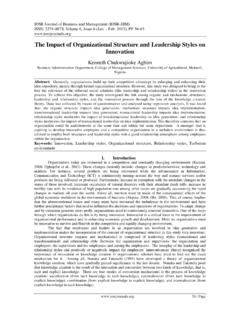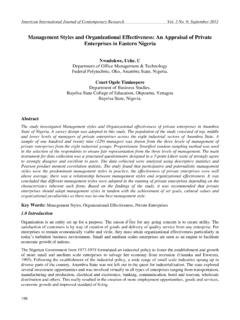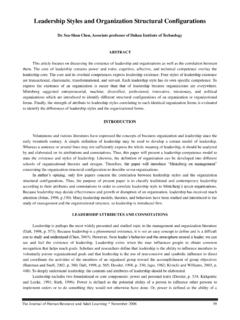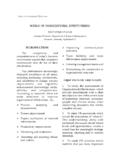Transcription of Clinical Supervision: Leadership Styles …
1 Clinical supervision : Leadership Styles Reviewed September 2017, Expires September 2019 Provider Information and Specifics available on our Website Unauthorized Distribution Prohibited 2017 , , , LLC By Wanda Lockwood, RN, BA, MA The purpose of this course is to explain the different Styles of Leadership and to outline the advantages and disadvantages of each style. Upon completion of this course, the healthcare provider should be able to: Describe the autocratic leader, including at least 4 advantages and disadvantages. Describe the bureaucratic leader, including at least 4 advantages and disadvantages. Describe the charismatic leader, including at least 3 advantages and disadvantages.
2 Describe the democratic leader, including at least 2 advantages and disadvantages. Describe the participatory leader, including at least 3 advantages and disadvantages. Describe the laissez-faire leader, including at least 2 advantages and disadvantages. Purpose Goal Introduction Most licensed healthcare providers must take a Leadership role as part of their professional duties, but many have little or no managerial training and are unaware of the different Styles of Leadership and the implications of each style. However, the ability to be a good leader is critically important to the person s effectiveness and advancement in the healthcare career. The first step in Leadership is for the individual to understand the options for Leadership and to determine the type of leader s/he is or aspires to be.
3 In many cases, the institution determines the focus of Leadership , and the healthcare provider should be aware of this focus before accepting a position. While there are many Leadership Styles , six stand out as commonly employed in healthcare. Autocratic leader The autocratic leader makes as many decisions independently as possible and maintains control of the decision-making processes. This leader also tends to retain responsibility and limit delegation and consultation with others. This is an older form of Leadership , often considered outdated, but this style remains common because there are advantages: Less stress: While the autocratic leader may have stress related to responsibility, the leader does not have the stress of his or her fate being in the hands of others.
4 Increased efficiency: The leader s oversight, presence, and expectations often result in people working to capacity at least while the leader is present. Advantages Rapid decision-making: The leader does not need to have meetings or make compromises to reach a decision, so the leader can respond quickly to changes or needs. Faster problem-solving: The leader who is heavily invested in all aspects of work can often spot problems quickly and come up with solutions. Less oversight: Because this leader makes decisions independently without consultation of staff, there is often less interaction and oversight into the manner in which the leader works or makes decisions. The autocratic leader strictly enforces his/her rules, but staff members often feel left out of process and feel their ideas are not expected or appreciated.
5 Because of this, staff may not be supportive, and there are several disadvantages: Negative work environment: The autocratic leader is often viewed with resentment because staff members feel they are not valued or appreciated. This can lead to lack of support and efforts to undermine the leader. People simply don t like to be ordered around regardless of the skills or abilities of the leader. Impaired staff development: Staff members are not able to gain experience and skills they need in order to advance or assume Leadership responsibilities. Unbalanced workload: The leader s workload may become unmanageable because of the person s inability or unwillingness to delegate. In the long run, this can result in increased stress, decreased efficiency, and burnout.
6 Dependency: When the leader makes all decisions, the staff may become very dependent on the leader, expecting more and more with less and less personal investment. Less feedback: Staff members often feel intimidated and afraid to point out problems, especially since they had no involvement in decisions about the process, so problems may go unreported and unaddressed. Disadvantages Autocratic leaders are especially effective in crisis situations when time is a critical element or in complex short-term projects. They are also effective in working environments with a rapid turnover of employees because the strict centralized control results in less time required for staff Leadership development and training.
7 However, the Leadership style may, in fact, contribute to rapid turnover. Some autocratic leaders are very effective because they have a clear vision and effective decision-making skills, but in many cases, people who are unsure of their abilities and lack Leadership skills retreat into autocratic Leadership because they simply don t know what else to do and believe that this type of Leadership exemplifies good Leadership by showing they are in charge. Bureaucratic leader Bureaucracy takes time to develop, so the bureaucratic leader is most often found in a large established institution in which top down decision-making has become the norm. Leaders are chosen because of their ability to follow organizational rules exactly, so they, in turn, expect others to do the same.
8 The bureaucratic leader is often quite business-like, focused on the job at hand, and ultimately signs off on all final decisions, so this authority gives the leader a certain degree of respect. There are advantages to bureaucratic Leadership : Clear structure: The lines of authority are clearly delineated, and people know what is expected of them within this structure. Increased safety: Because staff members follow rules, there is less danger of injury, so safety is often improved. Improved quality: When procedures are followed consistently, such as conducting time outs and checklists prior to surgery, quality of care often improves. Human error is reduced. Management control: When staff members know that their evaluations, promotions, salaries, and job security are tied to their exact following of established rules, they are less likely to deviate, so management can retain tight control.
9 Advantages The advantages to bureaucratic Leadership seem very positive; however, there are serious disadvantages that should not be overlooked: Negative work environment The bureaucratic Leadership model would be ideal for a workforce of robots, but people are not robots and often feel constrained by the need to constantly follow rules and frequently feel the work is unrewarding. Lack of creativity: Staff members are rewarded for following rules, not for questioning them or trying to arrive at better solutions. People who are creative often simply go elsewhere to work or learn quickly to keep ideas to themselves. Established procedures are often kept in place even though better procedures are used elsewhere.
10 Poor communication: The bureaucratic leader often refers to rules, regulations, and policies when dealing with problems, suggesting people follow the process rather than trying to resolve issues. Problems for which the rules are not clear are typically sent upward. Misconceptions regarding power: When position equals power, people often seek these positions because they want power over others, and leaders may develop inflated ideas of their own importance, expressed through arrogant behavior and increased politics as people attempt to curry favor. Inflated staff: Bureaucratic Leadership rarely results in a small efficient staff, as bureaucracy seems to lend itself to bloated staffing and waste.















